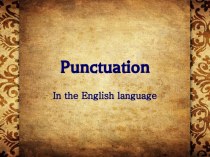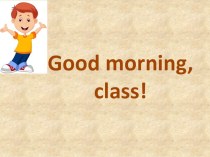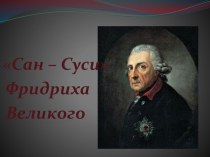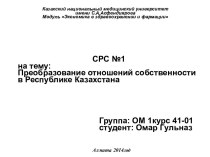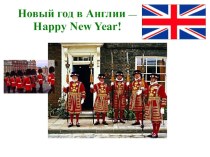- Главная
- Разное
- Бизнес и предпринимательство
- Образование
- Развлечения
- Государство
- Спорт
- Графика
- Культурология
- Еда и кулинария
- Лингвистика
- Религиоведение
- Черчение
- Физкультура
- ИЗО
- Психология
- Социология
- Английский язык
- Астрономия
- Алгебра
- Биология
- География
- Геометрия
- Детские презентации
- Информатика
- История
- Литература
- Маркетинг
- Математика
- Медицина
- Менеджмент
- Музыка
- МХК
- Немецкий язык
- ОБЖ
- Обществознание
- Окружающий мир
- Педагогика
- Русский язык
- Технология
- Физика
- Философия
- Химия
- Шаблоны, картинки для презентаций
- Экология
- Экономика
- Юриспруденция
Что такое findslide.org?
FindSlide.org - это сайт презентаций, докладов, шаблонов в формате PowerPoint.
Обратная связь
Email: Нажмите что бы посмотреть
Презентация на тему Stylistics of the English Language 6. Phonological expressive means and stylistic devices
Содержание
- 2. OutlinePhonological Expressive Means and Stylistic DevicesGraphical Expressive Means and Stylistic Devices
- 3. Phonological expressive means and stylistic devicesonomatopoeiaparonomasiastylistically marked errors in speech:malapropism spoonerismeggcornFreudian slipconsonance: alliteration assonancerhyme rhythm
- 4. Onomatopoeia the formation of a word by
- 5. Onomatopoeia: TypesDirect onomatopoeia is a combination of speech-sounds which
- 6. Direct Onomatopoeia: Names
- 7. Onomatopoeia: TypesIndirect onomatopoeia is a combination of
- 8. OnomatopoeiaI heard a Fly buzz – when
- 9. Paronomasiathe simultaneous use of different in meaning
- 10. ParonomasiaClaudius:…But now, my cousin Hamlet, and my
- 11. Errors in Speech: Malapropism (L. “inappropriate”)the
- 12. Malapropism“I’m fading into Bolivian.” (substituted “Bolivian” for
- 13. Spoonerismswitching the vowels or consonants in two
- 14. Spoonerism“Three cheers for our queer old dean!”
- 15. Eggcorn (from acorn)a substitution of a word or
- 16. Freudian Slipan unintentional utterance that may reveal
- 17. Task 1 Malapropism, Spoonerism, Eggcorn, Paronyms, Freudian
- 18. Consonance and Alliterationconsonance - a poetic device
- 19. Consonance and AlliterationAll’s well that ends well.Peter
- 20. Assonancea literary device characterized by the repetition
- 21. Assonance“But some punks want to jump up
- 22. Rhymerepetition of identical terminal sound combinations or
- 23. Rhyme: Typesperfect - mind and kind; toasting
- 24. Rhyme“Fate hired me once to play a
- 25. Rhythma regular repeated pattern of sounds in
- 26. Task 2 Onomatopoeia, Consonance, Alliteration, Assonance, Rhyme,
- 27. Graphical Expressive Meansgraphonitalicisation (italics )/ the use
- 28. Graphonthe intentional violation of the generally accepted
- 29. Graphon – Unconventional Graphologyrunning words together
- 30. Italicisationthe use of italics to highlight either
- 31. Capitalisationthe use of capital letters to emphasise
- 32. Repetition of lettersconveys hesitancy or emotionality in
- 33. Functions of phonetic and graphical meansTo
- 34. Task 3 Phonetic and Graphical Means(listen)this a
- 35. Task 3 AnalysisMessage: the poem describes a
- 36. Task 3 Analysis (2)Phonological level:the example of
- 37. Скачать презентацию
- 38. Похожие презентации
OutlinePhonological Expressive Means and Stylistic DevicesGraphical Expressive Means and Stylistic Devices
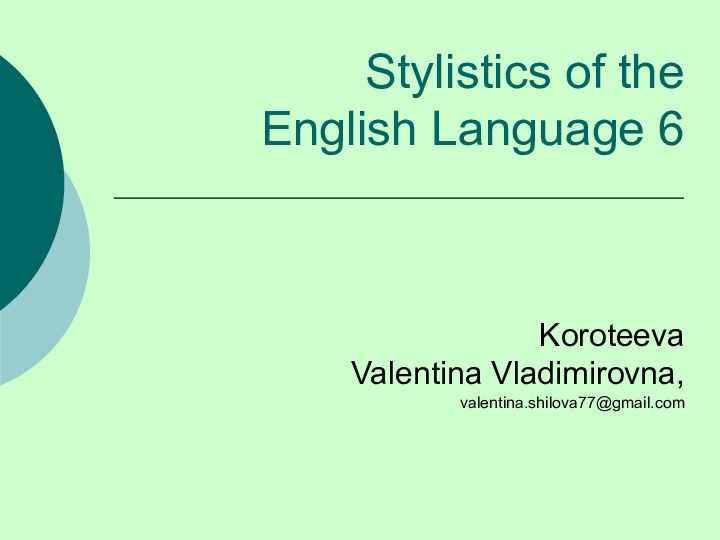
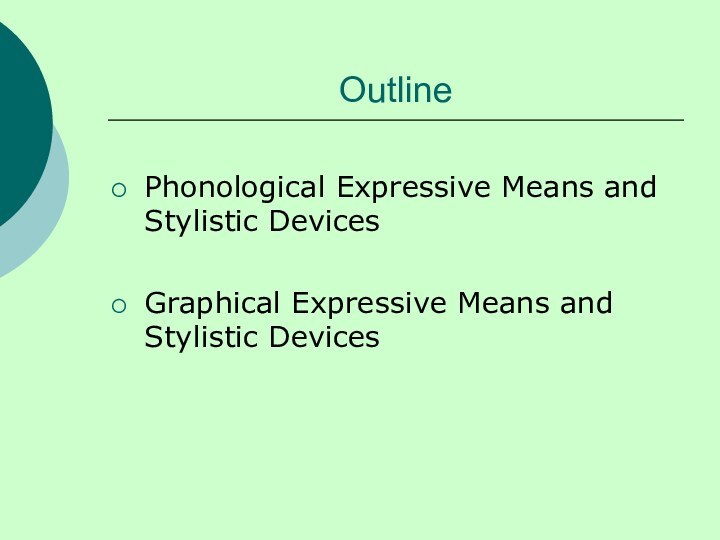







![Stylistics of the English Language 6. Phonological expressive means and stylistic devices ParonomasiaClaudius:…But now, my cousin Hamlet, and my son….. Hamlet: [aside] A little](/img/tmb/15/1459472/c51e46bdac65184f91d3d5a426cc3185-720x.jpg)


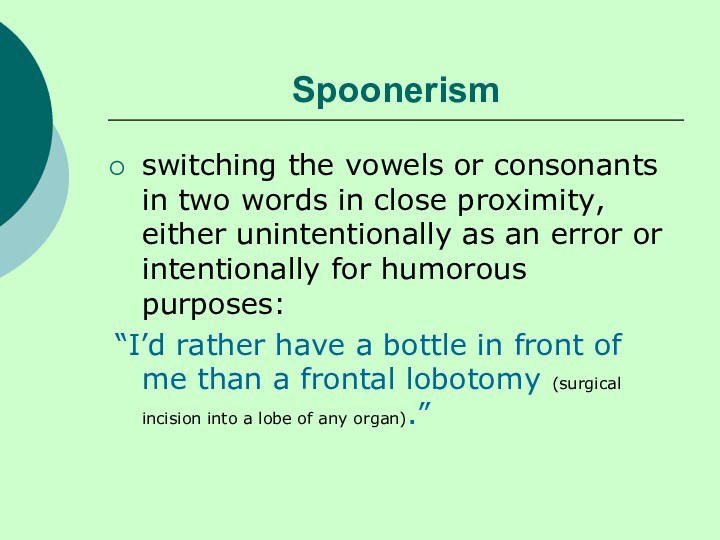


















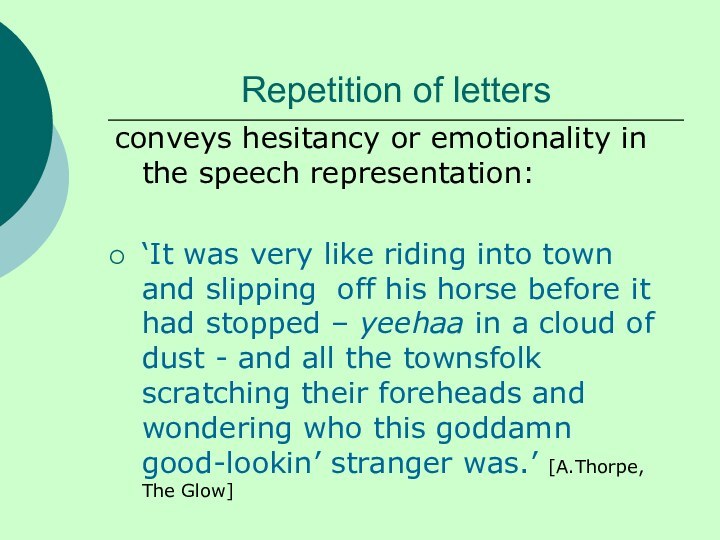





Слайд 2
Outline
Phonological Expressive Means and Stylistic Devices
Graphical Expressive Means
and Stylistic Devices
Слайд 3
Phonological expressive means and stylistic devices
onomatopoeia
paronomasia
stylistically marked errors
in speech:
malapropism
spoonerism
eggcorn
Freudian slip
consonance: alliteration
assonance
rhyme
rhythm
Слайд 4
Onomatopoeia
the formation of a word by imitating
the natural sound; the use of words whose sounds
reinforce their meaning or tone:On the word level: giggle, grumble, murmur; mew, roar; bubble, splash;
On the sentence level: “And the silken, sad, uncertain rustling of each purple curtain” (E.A.Poe)
Слайд 5
Onomatopoeia: Types
Direct onomatopoeia is a combination of speech-sounds which aims
at imitating sounds produced in nature (wind, sea, thunder,
etc.), by things (machines or tools, etc.) by people and by animals:Machine noises—honk, beep, clang, zap,
Animal names and sounds—twitter, croak, howl, cuckoo, whip-poor-will, whooping crane, chickadee
Impact sounds—boom, crash, whack, thump, bang
Sounds of the voice—shush, giggle, growl, whine, blurt, whisper, hiss
Nature sounds—splash, drip, whoosh, buzz, rustle
Слайд 7
Onomatopoeia: Types
Indirect onomatopoeia is a combination of sounds
the aim of which is to make the sound
of the utterance an echo of its sense. It is sometimes called “echo writing”: e.g. the imitation of the sounds produced by the soldiers marching over Africa:“We’re foot—slog—slog—slog—sloggin' over Africa — Foot—foot—foot—foot—sloggin' over Africa — (Boots—boots—boots—boots—movin' up an' down again!) There's no discharge in the war!”
[Boots (Infantry Columns) by R.Kipling (1903)]
Слайд 8
Onomatopoeia
I heard a Fly buzz – when I
died – The Stillness in the Room Was like the Stillness
in the Air – Between the Heaves of Storm –[“I heard a Fly buzz – when I died –” by Emily Dickinson]
Слайд 9
Paronomasia
the simultaneous use of different in meaning but
similar in sound words for euphonic (melodious) effect or
for the reinforcement of meaning or tone:‘Let us say then it is a story about appetite: appetite in its many aspects and dimensions, its perversions and falling off, its strange reversals and refusals.’ [H.Mantel, Experiment in Love, 69]
‘It (the love affair) maybe insane but it’s not inane (senseless).’ [This Side of Paradise by F.S.Fitzgerald]
***sometimes paronyms are considered as words which are a derivative of another and have a related meaning: ‘wisdom’ is a paronym of ‘wise’
Слайд 10
Paronomasia
Claudius:…But now, my cousin Hamlet, and my son…..
Hamlet:
[aside] A little more than kin, and less than
kind… Not so, my lord, I am too much in the sun……[Hamlet by William Shakespeare]
Слайд 11
Errors in Speech: Malapropism
(L. “inappropriate”)
the use of
an incorrect word in place of a word with
a similar sound (which is often a paronym), resulting in a nonsensical, often humorous utterancecomes from a character named "Mrs. Malaprop" in R.Sheridan’s 1775 play The Rivals. Mrs. Malaprop frequently misspeaks (to great comic effect) by using words which don't have the meaning she intends, but which sound similar to words that do
Characterture instead of charicature [To Kill a Mockingbird by H.Lee]
Слайд 12
Malapropism
“I’m fading into Bolivian.” (substituted “Bolivian” for “oblivion”)
“I
think he’s suffering from a nervous shakedown.” (substituted “shakedown”
for “breakdown)“This is unparalyzed in the state’s history.” (substituted “unparalyzed” for “unparalled”)
Слайд 13
Spoonerism
switching the vowels or consonants in two words
in close proximity, either unintentionally as an error or
intentionally for humorous purposes:“I’d rather have a bottle in front of me than a frontal lobotomy (surgical incision into a lobe of any organ).”
Слайд 14
Spoonerism
“Three cheers for our queer old dean!” (dear
old queen)
“A blushing crow.” (crushing blow)
“Is the bean dizzy?”
- ?“You have hissed all my mystery lectures!” - ?
Слайд 15
Eggcorn (from acorn)
a substitution of a word or phrase
for a word or words that sound similar or
identical. The new phrase introduces a meaning that is different from the original but plausible in the same context :“old-timer’s disease” for “Alzheimer’s disease”
“mating name” for “maiden name”
Слайд 16
Freudian Slip
an unintentional utterance that may reveal something
in the speaker’s unconscious:
if someone wanted to say,
“I really love chocolate,” but instead said “I really love Charlie,” this might hint at an unconscious desire
Слайд 17
Task 1 Malapropism, Spoonerism, Eggcorn, Paronyms, Freudian Slip
Let’s
focus on day-today operations.
Unfortunately, my affluence over my niece
is very small.You have tasted a whole worm.
Mercutio: “Nay, gentle Romeo, we must have you dance.” Romeo: “Not I, believe me. You have dancing shoes with nimble soles; I have a soul of lead … So stakes me to the ground I cannot move…” [Shakespeare]
Слайд 18
Consonance and Alliteration
consonance - a poetic device characterized
by the repetition of the same consonant two or
more times in a short succession, as in “all mammals named Sam are clammy”alliteration - a stylistic literary device identified by the repeated sound of the first consonant in a series of words: “friends and family”
creates aural harmony and rhythm
Слайд 19
Consonance and Alliteration
All’s well that ends well.
Peter Piper
picked a peck of pickled peppers.
Curiosity killed the cat.
A
blessing in disguise.“My fellow Americans, ask not what your country can do for you, ask what you can do for your country.”—John F. Kennedy
Слайд 20
Assonance
a literary device characterized by the repetition of
the same vowel sounds to create an internal rhyming,
to increase the stress on a subject or to add flair/expressivity:“I bring fresh showers for the thirsting flowers” (Shelly)
Слайд 21
Assonance
“But some punks want to jump up
With a
sharp tongue and their fronts up Like we got here
by dumb luck But they just want to become us.”[“Bangarang” by Doomtree]
Слайд 22
Rhyme
repetition of identical terminal sound combinations or words
in verse in order to produce euphonic effect, to
serve as a mnemonic device or to mark off the end of the lines:In 1492, Columbus sailed the ocean blue.
You have brains in your head; you have feet in your shoes. You can steer yourself any direction you choose. [Dr.Seuss]
Слайд 23
Rhyme: Types
perfect - mind and kind; toasting and
roasting;
imperfect (near) - wing and caring; thing and missing
identical
rhyme – way, weigh and wheyeye rhyme – good and flood
Слайд 24
Rhyme
“Fate hired me once to play a villain’s
part. I did it badly, wasting valued blood; Now when the
call is given to the good It is that knave who answers in my heart.”[“Between the Acts” by Stanley Kunitz]
Слайд 25
Rhythm
a regular repeated pattern of sounds in speech,
words, phrases, sentences; it is created by doubling of
words and sounds; polysyndeton, asyndeton; parallelism (anaphora, epiphora):No tree, no shrub, no blade of grass, not a bird or beast, not even a fish that was not owned!
Слайд 26 Task 2 Onomatopoeia, Consonance, Alliteration, Assonance, Rhyme, Rhythm,
Paronomasia
“Veni, vidi, vici.” [Julius Caesar]
“Season of mists and mellow
fruitfulness.” [Keats, "To Autumn“]“And the raven, never flitting, still is sitting, still is sitting.” [Poe, “The Raven”]
ba-ba in Chinese, tut-tut in French, pu-pu in Japanese, fom-fom in Portuguese and bim-bim in Vietnamese
“Oxford is a richly diverse community. At Oxford Today, we endeavour to reflect that diversity, reporting objectively and independently on developments, discoveries and debates (sometimes heated) within one of the most celebrated centers of learning.” [Oxford Today, 2009, 3]
Слайд 27
Graphical Expressive Means
graphon
italicisation (italics )/ the use of
boldface type
capitalisation
repetition of letters
violation of type and spelling
the use
of punctuation
Слайд 28
Graphon
the intentional violation of the generally accepted spelling
used to reflect peculiarities of pronunciation or emotional state
of the speaker; it is identified with the help of deliberate misspelling, hyphenation, capitalisation, apostrophe:“Aw – I b’lieve, the Umuricun revolution was lawgely an affair of the muddul clawses.” [S.Fitzgerald, This Side of Paradise, 8]
“Nemmine,” he managed to articulate drowsily. “Sleep in ‘em.” [S.Fitzgerald, This Side of Paradise, 192]
Слайд 29
Graphon –
Unconventional Graphology
running words together in unbroken
compounds: coffinlid, pettycoatbodice [Joyce]
graphically broken words: “How, is, my,
lit, tle, friend? how, is, my, lit, tle, friend?” [Dickens’s talking clock in Dombey and Son]
Слайд 30
Italicisation
the use of italics to highlight either the
meaning or the form of the word in question,
or to mark the way the word is pronounced:“Pale moons like that one” – Amory made a vague gesture - “make people mysterieuse. You look like a young witch…” [S.Fitzgerald, This Side of Paradise, 13]
Слайд 31
Capitalisation
the use of capital letters to emphasise the
meaning of the word, to mark headings or the
way the word or a sentence is pronounced:Mr.Podsnap addressing foreigners: “How Do You Like London?” [Our Mutual Friend by Ch.Dickens]
‘In other words you do an old familiar thing, like bottling dandelion wine, and you put that under RITES AND CEREMONIES. And then you think about it, and what you think, crazy or not, you put under DISCOVERIES AND REVELATIONS.’
[Dandelion Wine by Ray Bradbury, 1974, p. 15 ]
Слайд 32
Repetition of letters
conveys hesitancy or emotionality in the
speech representation:
‘It was very like riding into town and
slipping off his horse before it had stopped – yeehaa in a cloud of dust - and all the townsfolk scratching their foreheads and wondering who this goddamn good-lookin’ stranger was.’ [A.Thorpe, The Glow]
Слайд 33
Functions of phonetic and
graphical means
To emphasise the
meaning of the word/phrase in question
To draw the speech
portraitTo connote a certain atmosphere or mood
To add euphony and flair to the utterance
To assist in memorising particular information
Слайд 34
Task 3 Phonetic and Graphical Means
(listen)
this a dog
barks and
how crazily houses
eyes people smiles
faces streets
steeples
are eagerly
tumbl
ing through wonder
ful sunlight
[E.E.Cummings, 73 poems]
Слайд 35
Task 3 Analysis
Message: the poem describes a moment
of a happy revelation of a person, probably in
springtimeGraphical level:
the name of the poem is in brackets and not capitalised, which looks like a remark and creates the atmosphere of intimacy with the reader
there are no commas and no full stops in the poem, all the words are put together resembling the stream-of-consciousness technique - suggesting the lack of order, everything being in a whirl
the meaning of the word “tumbl ing” is reinforced on the graphical level (the word being set apart from the rest of the poem and graphically broken) – message – being dizzy with the sun and a lot of life (and love?) around
the word “wonder ful” is graphically broken to convey the idea of sunlight being full of wonder
Слайд 36
Task 3 Analysis (2)
Phonological level:
the example of direct
onomatopoeia ‘barks’ comes right after the name of the
poem ‘listen’ which immediately involves the reader;two incongruent feelings are brought up in the poem: at the beginning unexpectedness and dizziness by Z-consonance (crazily, houses, eyes, smiles, faces) and in the second part harmony and love by L-consonance (steeples, eagerly, tumbling, wonderful, sunlight)

